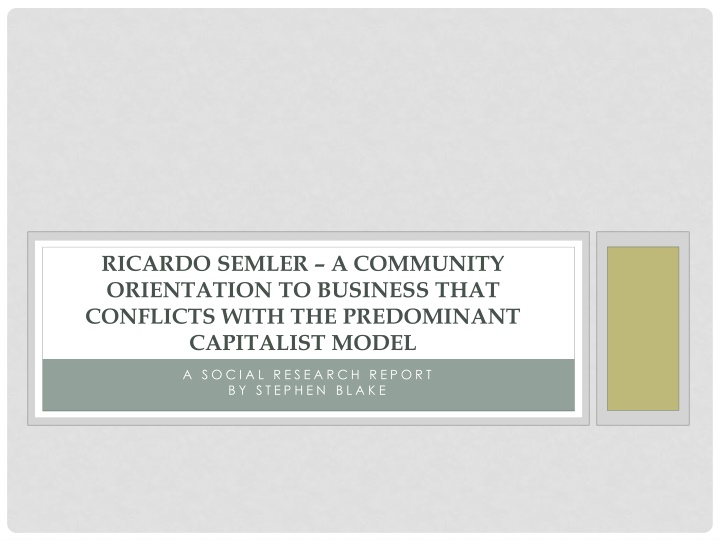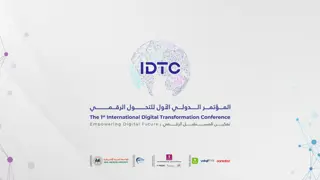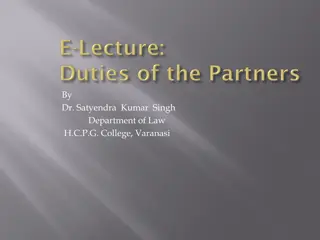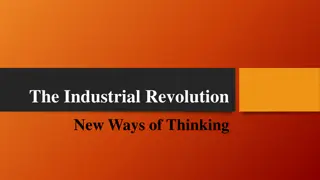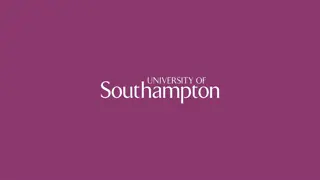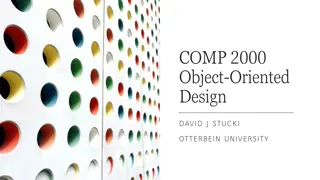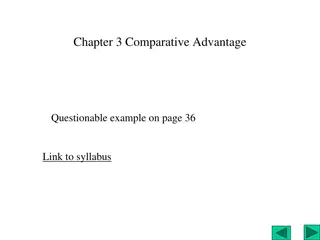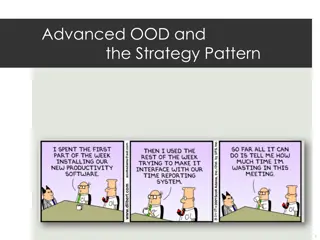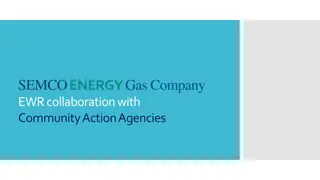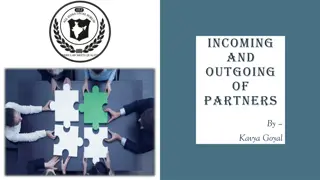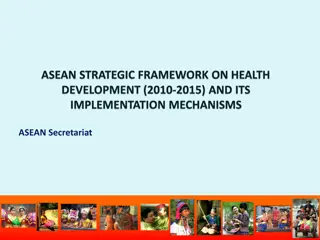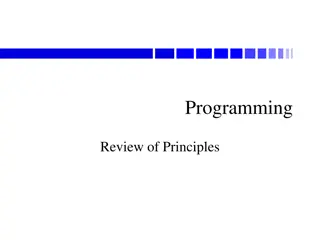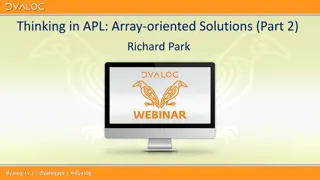Ricardo Semler and Semco Partners: A Community-Oriented Approach to Business Transformation
CEO Ricardo Semler led Semco Partners, a Brazilian company, through a radical transformation towards industrial democracy. Semler challenged traditional top-down structures, empowering employees and fostering a democratic work environment. This report delves into Semco's history, Semler's visionary leadership, and the evolution of their unique business model, highlighting the company's transition into a democratic organization.
Download Presentation

Please find below an Image/Link to download the presentation.
The content on the website is provided AS IS for your information and personal use only. It may not be sold, licensed, or shared on other websites without obtaining consent from the author.If you encounter any issues during the download, it is possible that the publisher has removed the file from their server.
You are allowed to download the files provided on this website for personal or commercial use, subject to the condition that they are used lawfully. All files are the property of their respective owners.
The content on the website is provided AS IS for your information and personal use only. It may not be sold, licensed, or shared on other websites without obtaining consent from the author.
E N D
Presentation Transcript
RICARDO SEMLER A COMMUNITY ORIENTATION TO BUSINESS THAT CONFLICTS WITH THE PREDOMINANT CAPITALIST MODEL A S O C I A L R E S E A R C H R E P O R T B Y S T E P H E N B L A K E
THE PURPOSE & FRAMEWORK OF THIS REPORT Analyse Identify Evaluate Contemporary Personal or Social Issue
IDENTIFY RICARDO SEMLER, SEMCO PARTNERS & HIS COMMUNITY ORIENTATION TO BUSINESS Ricardo Semler is the CEO and majority owner of Semco Partners a Brazilian company best known for its radical form of industrial democracy since Ricardo has taken over.
SEMCO PARTNERS HISTORY Semco was founded in 1953 by Ricardo Semler s father, Antonio Curt Semler. The company he founded was a typical South American run company for the time. It was rigidly hierarchical as a traditional top-down bureaucracy and it had a rule and a policy for just about anything. Ricardo joined the company at age 19 and straight away had conflicting views on the company and how it was run to his father. Ricardo s initial issues included the need for diversification and the company s financial practices. Most of all he disagreed with the company s rigid structure where he believed that the employees had to be baby-sat and controlled. All in which his father disagreed and thought otherwise.
SEMCO PARTNERS HISTORY It wasn t until 1980 when his father resigned as CEO leaving the majority of ownership to Ricardo, that he could finally make the changes he envisaged for Semco. One of his first official acts was to fire two-thirds of the top management, many of whom were his father's friends. He got to work changing the way business and planning was done. However, to begin with it was quite traditional. This would take its toll on the financial state of the company and Ricardo s personal health.
A CHANGE TO THE BUSINESS MODEL It wasn t until 1990 during a time when the Brazilian economy went into severe downturn, that the new Semco was born under Ricardo Semler. In an alternative to employee dismissals, under Semler s instruction workers began handling multiple job duties to come up with new procedures that saved time and money for the company. Management took a substantial cut in salary and all employees were given the right to approve every expenditure. As a result, Ricardo found that it gave workers greater knowledge of the operations and more suggestions on how to improve the business. So this business model was adopted and further developed as Semco became a democratic organisation.
SEMCO TODAY Today's Semco doesn't have a traditional management hierarchy or typical organisational chart, or even a lattice management structure. The company is effectively made up of autonomous, democratically run units. At the centre of these units are the Counselors, including Ricardo Semler. There are six of them and a different one takes the CEO job every six months. They deal with general policy and strategy, overall financial results, and work to inspire the Partners and Associates. Partners are six or seven leaders from each Semco division and all other employees are Associates.
SEMCO TODAY Associates set their own salaries which are publicly posted and worked into the budgets of the company. All meetings are open to all employees who want to attend and financial information is available to anyone who wants to see it with courses made available to help them understand the information. All leaders are evaluated anonymously by their peers every six months in a democratic style process. At Semco, processes are now controlled, not people. Self-directed people are hired and groomed. They decide where the company will go. Currently, Semco operates in eight different industries as a premium provider. All the business units operate at a profit. As such, providing grounds for self-direction was key not only to personal, but also organisational growth.
SEMLERS PHILOSOPHY ON BUSINESS AND LEADERSHIP Semler believes: A capitalist or bureaucratic model of business leadership is controlling and interferes with human dignity. Employees who participate in important decisions would naturally be more highly motivated and make better choices than those who simply follow orders from above. Leaving employees to form their own teams and spreading decision rights throughout the organisation is a way to engage the expertise of all employees. Organisations need to take away the boarding school aspects of business. Leaders must take a leap of faith and lose control.
RICARDO SEMLER TED TALK 2014 Ricardo Semler: How to run a company with (almost) no rules. TED.jpg Click on image to view video
ANALYSE COMPARING THE TWO BUSINESS/LEADERSHIP MODELS Bureaucratic Model Based upon fixed official duties under a hierarchy of authority. Apply a system of rules for management and decision making. Bureaucratic leaders work by the book following rules rigorously and ensure that their employees follow procedures precisely.
ANALYSE COMPARING THE TWO BUSINESS/LEADERSHIP MODELS Democratic Model Collegial style of running a team or organisation. Individuals are involved in the decision making process to determine what needs to be done and how it is to be achieved. Leaders facilitate conversation, encouraging people to share their ideas, and then synthesizing all the available information into the best possible decision.
HOW A LEADERSHIP MODEL INFLUENCES PEOPLE'S THINKING, VALUES & BEHAVIOUR The hierarchical control of a bureaucratic leadership model is a limitation of human freedom in which prevents spontaneity, creativity and individual initiative (Haralambos, Van Krieken, Smith & Holburn, 1996). People become used to hierarchical/bureaucratic structures which can be comforting because they know that someone else is responsible, takes the blame and has the headaches (Heller, as cited in Murphy, 2005). Bureaucratic Leadership Model In this style leaders are not dynamic and they never change their behaviour with the changing environment. Bureaucracy has significant impact on job satisfaction and more bureaucracy leads to more dissatisfaction among employees (Maqsood, Bilal, Nazir & Baig, 2013). In some situations, the inflexibility and high levels of control exerted from bureaucratic leadership can demoralize staff, and can diminish the organisations ability to react to changing external circumstances (Shyamala, Abiciniya & Mehar nisha, 2015).
HOW A LEADERSHIP MODEL INFLUENCES PEOPLE'S THINKING, VALUES & BEHAVIOUR Employees who feel their input is appreciated believe they can make a real difference to the company and to others. This environment will have people who are more motivated in their work and more likely to have a productive and satisfied workforce (Milliman, Czaplewski & Ferguson, 2003). Those who are open to meaningful and purposeful relationships, which are key aspects of community run organisations, are more likely to grow, learn and achieve a sense of purpose in their work (Trott, as cited in Milliman, Czaplewski & Ferguson, 2003). Democratic Leadership Model People support what they create, therefore employees must be given the opportunity to always participate in the development of those things that affect them. A democratic system allows for collaboration to affiliate with those who share a similar sense of what is important (Wheatley, 1999). Organisations where leaders encourage collaboration, model a balanced life and build cohesive learning communities enhance ones journey to mainfest mind, heart and spirit at work (Ashar & Lane-Maher, 2004).
SEMCOS POSITIVE CHANGE IMPLEMENTED BY RICARDO SEMLER Healthy Workplace Spirituality Organisationa l Culture Distributed/ Shared Leadership Improvement in Organisational Performance
EVALUATEWHY RICARDO SEMLERS NEW BUSINESS/LEADERSHIP FRAMEWORK WORKED Distributed/Shared Leadership Model Distributed perspective on leadership is grounded in activity rather than position and role (Spillane, Halverson & Diamond, 2001). Ricardo Semler decided to concentrate on the activities of the company from the viewpoint of all employees not because of the position they fill. He had the courage to take the leap of faith and lose control that he describes is the hardest thing to do for leaders who are in a position of power. No matter how ingenious a business owner is, it is virtually impossible for a single individual to generate the range of strategic ideas possible in a large organisation. Ricardo found that through the input of all employees he was able to utilise each individuals expertise, thoughts and opinions. This collaboration led to individuals becoming more engaged, responsible, ethical and creative within the organisation because they found meaning in their activities and their thoughts and opinions mattered (Gull & Doh, 2004). Leaders don t get extraordinary things done by themselves, leadership is a reciprocal process between leaders and their constituents (Kouzes & Posner, 2008). Ricardo Semler s community orientation to business is built upon this reciprocal process. Each individual employed at Semco has a say on how the company is run and their own job description. This process demonstrates the trust Ricardo Semler has for his employees and this is then reinforced through the success of the company under his style of management. It clearly displays that people trust leaders when their deeds and words match (Kouzes & Posner, 2008).
EVALUATEWHY RICARDO SEMLERS NEW BUSINESS/LEADERSHIP FRAMEWORK WORKED Organisational Culture The attitudes, behaviours, core values, perceptions, and prejudices that shape a business are embedded in its culture. When leaders won t examine and change their own behaviours and patterns, positive culture construction begins to fail. Ricardo Semler sat back for many years and watched his father create a organisational culture that he did not agree with. He understood that people are often unaware of an organisation s culture until it is challenged, they experience a new culture or it is made explicit through a framework or model (Cameron & Quinn, 2006). So when he took control he set out to change Semco s culture for the improvement of the organisation. Semler knew that the previous culture was based around a capitalist model where the company and its profits were the centre point. He adopted a change where the culture would now respond to the needs of individuals as well as teams and the overall organisation. This new culture would become the glue that holds all the individuals, interpersonal relationships and teams together. It would give cohesion to the entity through which employees could always collaborate to achieve a larger purpose (Hultman & Gellermann, 2002).
EVALUATEWHY RICARDO SEMLERS NEW BUSINESS/LEADERSHIP FRAMEWORK WORKED Healthy Workplace Spirituality Creating and articulating a shared vision is essentially a spiritual activity that helps a workgroup move towards community (Moxley, 2000, p36). Ricardo Semler s final goal was to improve workplace spirituality and employee work attitude through this new shared vision of a community/democratic framework to the Semco organisation. This community based organisation that valued equality led employees to a new found meaning in their work, no matter their position within the company, resulting in enhanced organisational performance.
EVALUATEWHY RICARDO SEMLERS NEW BUSINESS/LEADERSHIP FRAMEWORK WORKED Healthy Workplace Spirituality Meaningful Work & Community Organisational Performance Inner Life (Ashmos & Duchon, 2005)
EVALUATEWHY RICARDO SEMLERS NEW BUSINESS/LEADERSHIP FRAMEWORK WORKED Healthy Workplace Spirituality Through the new collaborative approach implemented by Semler, employees became part of a working environment where a person of high importance within the organisation cared about what they do and about the people they are revealing a priority of workplace spirituality (Starratt & Guare, 1995). An organisation s spirituality is grounded in its culture, influenced by the values in practice (Gull & Doh, 2004). Semco s culture was now influenced by the values of care, appreciation, and trust that was practiced by all employees no matter their position of responsibility within the company. Through his spiritual leadership, Ricardo Semler was able to lead relationships with internal and external communities resulting in a balanced operating environment through process and teamwork, internal networks and teams and people enjoying work with a sense of identity and fulfillment (Korac-Kakabadse, Kouzim & Kakabadse, 2002).
CONCLUSION Different strategies, structures and leadership styles unsurprisingly create distinctive organisational cultures. Semco, under the direction of Ricardo Semler, serves as a vivid example of a human-centered organisational culture that defies all business tradition (Bock, 2005). Ricrado Semler s community orientation to business displays three core dimensions of workplace spirituality. These include purpose in one's work or "meaningful work" (individual level), having a "sense of community" (group level), and being in "alignment with the organisation's values" and mission (organisation level) (Milliman, et al., 2003). He changed the entire landscape of the company. From a bureaucracy to a democracy, a hierarchy to a community with values alignment and a positive working environment flourished. However, to his amazement, this business framework or leadership structure remains the minority in use across organisations worldwide today. Like Ricardo, leaders must continue their search for wisdom within their organisations through the expertise of their employees and have the courage to lose control and promote shared leadership and a democratic framework to business.
REFERENCES Ashar, H. & Lane-Maher, M. (2004). Success and sustainability in the new business paradigm. Journal of management inquiry, 13(3), 249-260. Ashmos, D. & Duchon, D. (2005). Nurturing the Spirit at Work: Impact on work unit performance. In The Leadership Quarterly 16:5. pp. 807-833. Bock, W. (2005). Supervisory Leadership: Lessons from Semco on Structure, Growth and Change. Retrieved from http://www.agreatsupervisor.com/articles/lessons.htm Cameron, K. & Quinn, R. (2006). Diagnosing and Changing Organizational Culture. Revised Edition. USA: The Jossey-Bass Business & Management Series. Gull, G. & Doh, J. (2004). The Transmutation of the Organization: Toward a More Spiritual Workplace , Journal of Management Inquiry 13, 128 139. Haralambos, M., Van Krieken, R., Smith, P. and Holburn, M. (1996) Organisations and bureaucracy. In Sociology: themes and perspectives. Australian edition. pp. 327-375. South Melbourne: Longman. Hultman, K. and Gellermann, B. (2002), Balancing Individual and Organizational Values: Walking the Tightrope to Success, Jossey-Bass/Pfeiffer, San Francisco, CA. Korac-Kadabadse, N., Kouzmin, A., & Kakabadse, A. (2002). Spirituality and leadership praxis. Journal of Managerial Psychology, 17 (3), 165-182.
REFERENCES Kouzes, J. & Posner, B. (2008). Credibility is the foundation of leadership. In The Leadership Challenge. Chapter Two, pp. 27 42. San Francisco: Jossey-Bass Maqsood, S., Bilal, H., Nazir, S. & Baig, R. (2013). Manager s Leadership Styles and Employee s Job Satisfaction. In Human and Social Science Research Vol. 1(2), pp.139-144 Milliman, J., Czaplewski, A. J. and Ferguson, J. (2003). Workplace spirituality and employee work attitudes: An exploratory empirical assessment. Journal of Organizational Change Management, 16, pp.426 447. Moxley, R.S. (2000). Understanding and experiencing Spirit. In Leadership and Spirit: Breathing New Vitality and Energy into Individuals and Organizations (pp. 21 41). San Francisco: Jossey-Bass. Murphy, J. (2005). Confronting Organizational and cultural barriers. In Connecting teacher leadership and school improvement, pp. 97-127. Thousand Oaks: Corwin Press. Shyamala, P., Abiciniya, A. & Mehar nisha, M. (2015). Leadership during time complexity and changes area: Human Resource. In Journal of Business and Management, pp. 52-57. Spillane, J., Halverson, R. & Diamond, J. (2001). Investigating school leadership practice: a distributed perspective. In Educational Researcher, pp. 23-28. Starratt, R. J., & Guare, R. (1995). The Spirituality of Leadership. In Planning and Changing, 26 (3/4), 190 203. Wheatley, M. (1999). Bringing schools back to life: Schools as living systems. In Creating successful school systems: Voices from the university, the field, and the community, pp. 1-11. : Christopher-Gordon Publishers.
